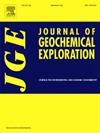Numerical simulation of a base metal deposit related to a fossil geothermal system
IF 3.4
2区 地球科学
Q1 GEOCHEMISTRY & GEOPHYSICS
引用次数: 0
Abstract
Fossil and active geothermal systems that produce ore deposits are sites of complex physicochemical processes and a favorable combination of factors related to the amount of metal-bearing fluid that flows through the system, ore fluid metal concentrations, depositional efficiency, and the duration of ore deposition. Of all these factors, the length of the mineralizing event is one of the least understood aspects of ore genesis.
We used fluid inclusion data, chemical compositions of base metal sulfides, and fluid flow rates to constrain a reactive-transport model of a fossil geothermal system - the Patricia Zn-Pb-Ag deposit in northern Chile. The Patricia deposit consists of quartz and base metal sulfide veins of hydrothermal origin with structural control, hosted in a volcanic succession with intense propylitic alteration. The fluid inclusions are liquid-rich, with homogenization temperatures ranging from 250 to 150 °C and salinities between 22 and 1 wt% NaCl equiv., with an early fluid mixing trend and no evidence of boiling in the system. Sulfide mineralogy indicates intermediate sulfidation conditions.
To identify the most relevant geochemical and transport parameters controlling the formation of this fossil geothermal system >1000 simulations were performed using the reactive-transport code TOUGHREACT. The paragenesis of the deposit is mimicked by a model of successive stages of fluid circulation consistent with the observed mineral assemblage distribution, the fluid inclusion data, and the estimated resources in the deposit.
The entire geothermal activity of the system was modeled considering 10,000 years of fluid-rock interaction, with periods of circulation of metal-barren fluids followed by metal-rich fluids driving the ore formation. In the initial model, base metal solubility with predominant chloride complexing suggests that the most efficient ore-forming mechanism for the Patricia deposit was the result of the interaction of two different fluids, one fluid transporting metals and another fluid transporting reduced sulfur, mixing in a rock volume of high permeability. Mass balance estimations with this model give a period of 3500 to 5000 years for the ore stage duration in which all the ore resources of the Patricia deposit could have been precipitated by fluid mixing.
In a second model, the previous estimates for the duration of the main ore stage were used to simulate the fluid-rock interaction during the ore stage for 3500 years. The results indicated the importance of the permeability of the host rock enhanced by fractures to concentrate the volume of the mineralization and the role of the hydrothermal alteration assemblage in controlling the circulating fluid acidity. A higher efficiency in forming sulfide minerals appears to coincide with pH values ranging from 5.1 to 5.3.
The results of both models are validated by replicating the system evolution, reproducing the same mineral alteration assemblage, the expected base metal resource distribution, and similar amounts of ore resources to those of the Patricia deposit: a total of 52,602 tons of lead and 157,731 tons of zinc. The models indicate that the hydrothermal event might be two times longer than the ore stage.
与化石地热系统有关的贱金属矿床的数值模拟
产生矿床的化石和活动地热系统是复杂物理化学过程的场所,也是与流经系统的含金属流体量、矿石流体金属浓度、沉积效率和矿石沉积持续时间有关的各种因素的有利结合。我们利用流体包裹体数据、贱金属硫化物的化学成分和流体流速来约束化石地热系统--智利北部帕特里夏锌铅银矿床--的反应传输模型。帕特里夏矿床由热液成因的石英和贱金属硫化物矿脉组成,受结构控制,位于具有强烈丙烷蚀变的火山岩演替中。流体包裹体富含液体,均化温度在 250 至 150 ° C 之间,盐度在 22 至 1 wt% NaCl 当量之间,具有早期流体混合趋势,系统中没有沸腾迹象。为了确定控制这一化石地热系统形成的最相关地球化学和传输参数,我们使用反应传输代码 TOUGHREACT 进行了 1000 次模拟。根据观察到的矿物组合分布、流体包裹体数据和矿床的估计资源量,通过流体循环的连续阶段模型模拟了该矿床的成因。在初始模型中,基本金属溶解度和主要的氯化物络合作用表明,帕特里夏矿床最有效的成矿机制是两种不同流体相互作用的结果,一种流体输送金属,另一种流体输送还原硫,在高渗透性岩体中混合。根据该模型的质量平衡估算,矿石阶段的持续时间为 3500 至 5000 年,在此期间,帕特里夏矿床的所有矿石资源都可能通过流体混合而沉淀下来。结果表明,裂缝增强了主岩的渗透性,这对集中矿化体积非常重要,热液蚀变组合对控制循环流体酸度也很重要。通过复制系统演化、再现相同的矿物蚀变组合、预期的基本金属资源分布以及与帕特里夏矿床相似的矿石资源量(共计 52,602 吨铅和 157,731 吨锌),验证了这两个模型的结果。模型显示,热液事件可能比矿石阶段长两倍。
本文章由计算机程序翻译,如有差异,请以英文原文为准。
求助全文
约1分钟内获得全文
求助全文
来源期刊

Journal of Geochemical Exploration
地学-地球化学与地球物理
CiteScore
7.40
自引率
7.70%
发文量
148
审稿时长
8.1 months
期刊介绍:
Journal of Geochemical Exploration is mostly dedicated to publication of original studies in exploration and environmental geochemistry and related topics.
Contributions considered of prevalent interest for the journal include researches based on the application of innovative methods to:
define the genesis and the evolution of mineral deposits including transfer of elements in large-scale mineralized areas.
analyze complex systems at the boundaries between bio-geochemistry, metal transport and mineral accumulation.
evaluate effects of historical mining activities on the surface environment.
trace pollutant sources and define their fate and transport models in the near-surface and surface environments involving solid, fluid and aerial matrices.
assess and quantify natural and technogenic radioactivity in the environment.
determine geochemical anomalies and set baseline reference values using compositional data analysis, multivariate statistics and geo-spatial analysis.
assess the impacts of anthropogenic contamination on ecosystems and human health at local and regional scale to prioritize and classify risks through deterministic and stochastic approaches.
Papers dedicated to the presentation of newly developed methods in analytical geochemistry to be applied in the field or in laboratory are also within the topics of interest for the journal.
 求助内容:
求助内容: 应助结果提醒方式:
应助结果提醒方式:


